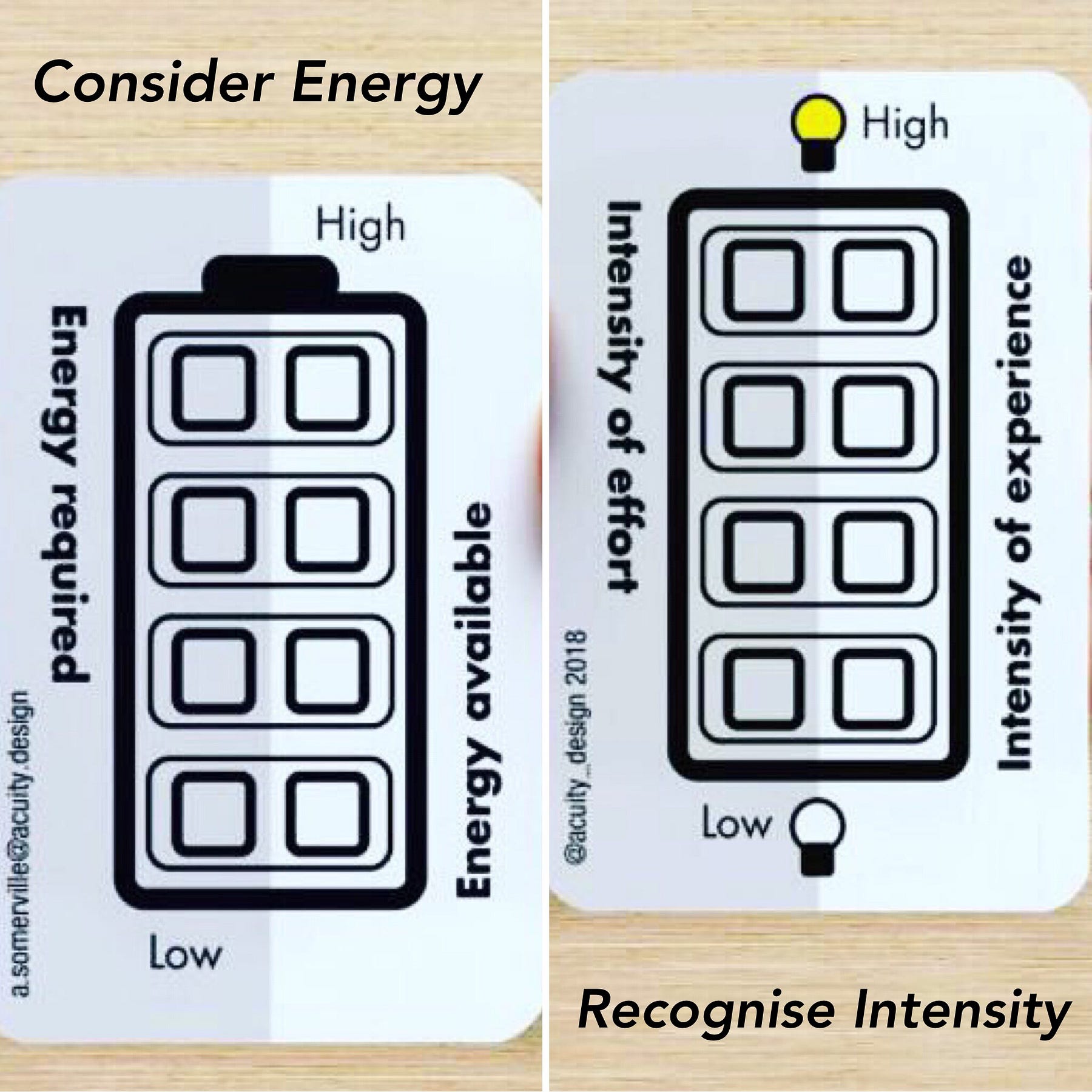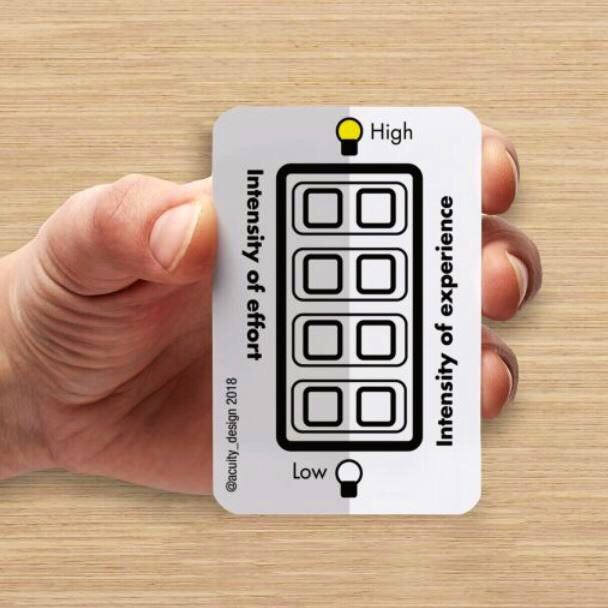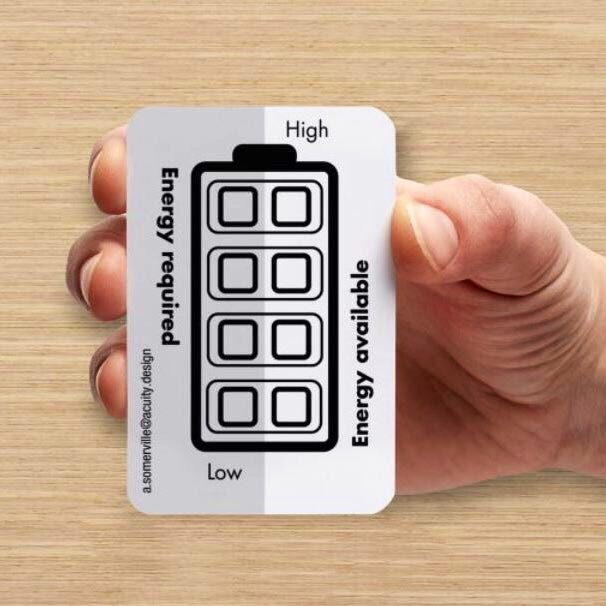
I’ve been working on Cognitive Accessibility projects over the last couple of years and how to enable open conversations about personal capacity without losing personal autonomy keeps coming up. Asking people to talk of their own capabilities and how the environment around them (both architectural and social) affects them is hard. It exists on a line between what is within and outwith. Crossing that line, both in terms of inquiry and in terms of revealing personal experiences, is problematic.
What to speak of?
I have divided the issues into two main parts:
- Intensity
- Energy
Intensity

In the design work I’ve done in physical and digital environments (particularly for museums), the main issue that comes up is Intensity. So many places designed to be overwhelming in terms of sensory experiences. I have worked on many projects trying to mitigate such experiences.
Intensity is generally public – it’s perceivable if you make yourself aware. How intensity affects people is also generally visible – I have spent a lot of time observing how people react to places.
Intensity of Experience
This is the central element of perception. How loud, how bright, how smelly, how crowded an experience can be.
This is the type of Intensity what is most often audited and tested.
Intensity of Effort
Intensity of effort is one element of the newer practice of Cognitive Accessibility. It builds on ideas from books like “Don’t Make Me Think” to recognise how some products and services can be simply too hard to understand and use.
The intensity is both within the person and outwith them in the product. You cannot do what you want because it is too hard to work out what to do and to keep doing for the length of time required.
Usability testing of products can touch upon this kind of intensity but often presumes a very normalised senses of personal capacity.
Energy

Energy is the flipside of Intensity. How much energy you feel you have and how much you feel you will need. These are both within you and both based on your own judgement.
Energy available
How much energy you have at this moment is a crucial judgement that changes as you go from one place to another, from one day to another.
This is the most basic piece of self-awareness. The basic and visceral sense of how much energy you feel you have.
Energy required
How much energy you need is a prediction based on your judgement. It is about thinking about energy needs over time and places.
This is a personal opinion but can be helped by discussion with others.
Speaking of Comfort and Discomfort
Telling other people about Intensity and Energy is the point of the cards but telling people is also about privacy (this is your experience) and autonomy (telling another person does not mean they get to take away your ability to make choices or take actions).
Telling your truth is hard and the cards are an attempt to find a way to negotiate that.
Telling you my truth of a time and a place
The cards are meant to enable discrete communication in a moment – in a specific place and time – with a friend or trusted colleague.
They are cards so they are not digital. They’re physical and analogue so no data is collected. They exist in that moment in your presence and shared with who you choose.
They are not really meant to be reusable as the point is to communicate how the feelings of energy and intensity are contextual. It’s about this time and this place. In another time and in another place, you would not feel this way.
When talking about these kind of issues, it is much too easy for people (who you do not know well) to:
- not be at all aware that there are any problems at all
- listen and help but think that this issue is how you feel in all other places and times
Helping people understand how you change and how they can be aware of needs and capacities that are contextual and not permanent can be useful.
How you feel is personal and private. Communicating discomfort depends on trust both in that specific time and place and in the future. What is communicated now is something that affects the future.
Ensuring people do not think that what you want to say now is what they must think is true in the future is one reason the cards are designed to be disposable. Their temporariness is part of the message.
The message you communicate is yours. The ideas you communicate is about this time and place. The message and the ideas are contextual and not to be taken as permanent.
Share your sense of discomfort but throw the card away later.
Things change, you change.
Download sample cards
You can download a free A4 sample set of cards from Dropbox: A4 Intensity/Energy Cards

Please let me know if they help.
Buy cards

I have had some cards professionally printed.

I’m happy to send cards for free to people in UK but if some people could buy them on Etsy then that offsets the costs of printing.
You can buy packs of 25 cards for $6 plus P&P (from c. $1 in UK to $2.25 for anywhere in the world) from Etsy: Energy Intensity Cards.
Prototyping and improving
This is all about experimenting and trying to make things that help so I am happy to chat about what works and what fails.
PS
People may be aware of the concept of Spoon Theory in terms of energy planning. I have deliberately not used that metaphor as I do not want to appropriate it. This is an issue of respect that I am highly aware of and know I can fail at.